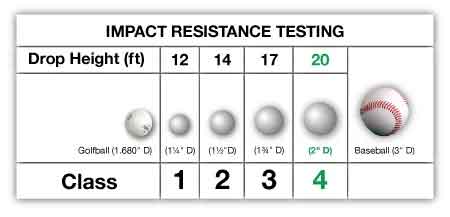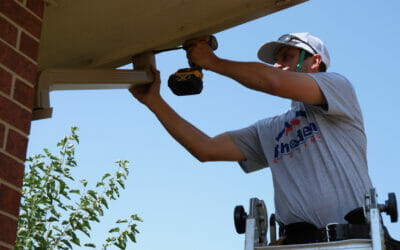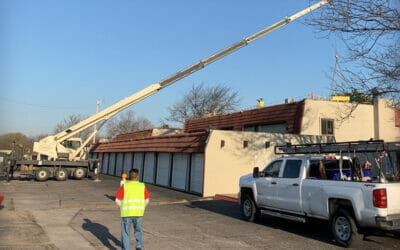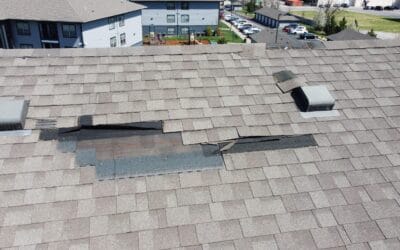Should I Invest in a Class 4 Impact Resistant Shingle on My Home?
There are many important things to consider when replacing your roof. What type of products should I choose? What color or design to choose? Is it really worth it to upgrade my roof? One of the most common upgrades that homeowners consider when replacing their asphalt shingle roof is installing Class 4 rated shingles.  Hail damage on a roof can crack or displace shingles, cause granule loss, or break the shingle seal, which lead to water leaks inside your home. As the “impact-resistant” name suggests, the primary purpose of a Class 4 rated shingle is its resistance to hail damage (more detail on rating specifications here). However, the additional thickness and durability of a Class 4 shingle also increases the longevity of the roof, add resistance to falling or scraping tree branches, and help protect from flying debris (especially here in Kansas with our famous wind).
Hail damage on a roof can crack or displace shingles, cause granule loss, or break the shingle seal, which lead to water leaks inside your home. As the “impact-resistant” name suggests, the primary purpose of a Class 4 rated shingle is its resistance to hail damage (more detail on rating specifications here). However, the additional thickness and durability of a Class 4 shingle also increases the longevity of the roof, add resistance to falling or scraping tree branches, and help protect from flying debris (especially here in Kansas with our famous wind).
Benefits of Class 4 Rated Shingles:
- Class 4 rated shingles usually carry a 50-year product warranty from manufacturers and non-class 4 shingles usually carry a 30-yr warranty.
- Class 4 rated shingles are far more durable and will provide longevity and protection for your home.
- Saving money. Yes, saving money! Most insurance companies provide discounts for their policyholders who upgrade to a Class 4 (impact rated) shingles. Insurance discounts you can receive vary from company to company, but some are as high as 33% off the annual premium in markets such as here in Wichita where the most common claim made is for hail damage to your roof. In many cases, the insurance savings on your homeowner’s policy can pay for the upgrade in about 2-3 yrs.
- After a moderate hailstorm, homeowners are less likely to need replacement of their roof and incur the deductible expense and hassle of replacing the roof again.
- In climate areas that get hail, having a Class 4 roof is a selling point on your home for real estate transactions, and commands a premium from buyers who want the increased protection and reduced homeowner’s insurance premiums.
- The sturdier Class 4 shingles allow most manufacturers to increase their wind rating from 110 MPH (standard) to 130 MPH.
- In the event of extreme hail or other events that damage your roof, homeowner insurance typically covers “like-kind” replacements, meaning that if you already have a Class 4 impact-resistant shingle roof, you will be covered for a Class 4 replacement without having to pay a second time for the upgrade.
Overall, Class 4 rated shingles are superior to typical asphalt shingle roofing products. It can be well worth it to know that your roof will provide extended protection and long-term cost savings. Let’s explore the costs and other decision factors when considering an upgrade.
Costs of Upgrading to a Class 4 Shingle
Why doesn’t everyone upgrade to Class 4? Material cost. While the labor costs to install are the same, the materials price of the shingles themselves is higher for Class 4 rated, impact-resistant products. Additionally, if you are replacing your roof as part of an insurance claim, the upgrade will be an out-of-pocket expense to the homeowner (more on this below). Does it make sense to upgrade my roof to a Class 4 shingle if my current roof is in good shape? In most cases, no. Shingles are a just one part of a new roofing system, which is a major construction project. Most people choose to upgrade to a higher-quality shingle during new home construction, or when they have roof damage or an old roof that warrants replacement. How much more does it cost to install a roof with Class 4 shingles? Approximately 10% more. This is a basic guideline that works for single-family residential homes, at least for the purposes of back-of-a-napkin type estimates. Building material prices change all the time, but the percentage difference remains relatively steady between standard and Class 4 shingles so we can use percentage difference to compare. A look back at our actual job cost sheets from the last few years reflect a range between 7% and 18% increase in the total price of the new roof when the shingles are upgraded to Class 4. The installation process is the same, so labor amounts for the job remain fixed, as well as the other materials for the roofing system (underlayment, flashing, gutters, etc.). The cost to upgrade is just a reflection of the price difference for the shingles themselves. What percentage of a roof installation cost is shingles? About 35%. Looking at our actual job cost sheets for single-family residential roof replacements, roughly 70% of total costs are materials (half of which is shingles), and 30% is labor. Does homeowners insurance pay for an upgrade to Class 4 shingles? No, but you may receive a discount on your future premiums after upgrading, depending on your insurance carrier. In the event of a claim, insurance companies pay for “like-kind” products, meaning a claim will pay to replace what is currently there. The difference in cost between the regular and Class 4 shingles themselves is the out-of-pocket cost to the homeowner. Even in areas of the country that receive hail, building code (which defines minimum standards) does not require impact-resistant shingles so it is considered a premium upgrade. However, if you already have a Class 4 impact-resistant asphalt shingle, you will not have to pay to upgrade again in the event of a claim. This is one advantage of making the upgrade in the first place, as you get to “keep” the higher quality roof. So should I invest in a Class 4 impact-resistant shingle on my home? We’re back to the original question. If you consider your home to be a long-term investment, “yes,” we think so. Let’s look at an example home under consideration:
Example Home on Willow Street
- $15,000 roofing project.
- For this particular house, the cost to upgrade to Class 4 is right around 10%, or $1,500.
- The homeowner has a typical wind/hail deductible of $2,000.
Over the life of the roof in our Willow Street example, if the homeowner is saved from having to file even one claim, then the upgrade has paid for itself. Additionally, in the event where there are no claims, an added 10-20 years of longevity to the roof could be worth thousands per year in benefit by deferring the cost of a roof replacement. Even if you aren’t in a forever home, the added value when selling the home and peace of mind about roof damage when living in the home may still be compelling reasons to look at upgrading to a Class 4 roof.
Additional Reading and Other Decision Factors:
Some other relevant questions you may be asking when considering a roof upgrade to Class 4 shingles:
- Do you have factors on your roof that will make the labor more expensive? Roofs with steeper slope, more faces, dormers, difficult access, or that are 2+ stories off the ground require more work and equipment to re-roof. The installation process is no different between a regular and Class 4 shingle, but the proportional cost of the shingle upgrade compared to the total install cost is lower on a more complex roof. Additionally, the financial benefit of increased longevity is greater on a more difficult/labor-intensive roof.
- Do you have large trees on your property that overhang the roof? This is especially relevant for certain tree types known to frequently drop falling branches, such as cottonwoods and certain species of oaks, or fast-growing trees whose branches are more likely to brush or scrape roof surfaces even with annual trimming.
- Are the same colors available in Class 4 rated shingles? For the most part, yes, but this is dependent on the specific manufacturer. For less common colors, the upgraded shingles may have longer lead times.
- Can I change from a 3-tab shingle to a Class 4 rated shingle? Yes. However, the price difference will be greater than changing from an architectural (also known as “laminated” or “dimensional” shingle) because 3-tab shingles are typically the cheapest/least durable type of asphalt shingles. If the roof is being replaced as part of an insurance claim, the out-of-pocket difference will be greater.
- Does the steepness of my roof change my need for impact-resistant shingles? No. Ratings are not dependent on the impact angle.
- Are Class 4-rated roofing materials always asphalt shingles? No, many different types of roofing materials can meet the standards for a Class 4 impact-resistant rating. This article discussed upgrading from a traditional asphalt shingle to one with a Class 4 rating because that is the most common upgrade, but some people choose to go with concrete or clay tile, metal panel, metal shingle, slate, or composite shake tiles, all of which can have a Class 4 rating.
- Who determines Class 4 ratings, and what does that entail? See more details in this article.
This article is part of our ‘Residential/ Steep Slope Materials’ Series. Learn more about:
- Asphalt Composite Shingles
- Metal Roofing
- Wood/ Cedar Roofing
- Other
- Roof Component Materials
- Traditional “Organic” Felt vs Synthetic Underlayment: Which is better?
- What Is the Difference Between Open and Closed Valley Installation?
- Continuous Venting Ridge vs Static/Box Vents: Which is better?
- What Are the Benefits to a High Profile Hip and Ridge Shingle?
- What Is a Class 4 Rating? Who Makes That Determination?



